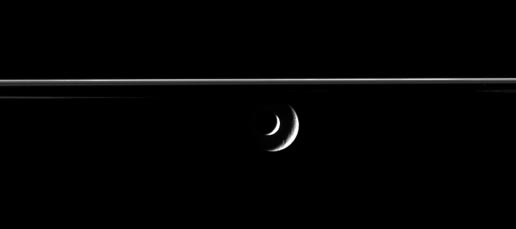
Credit: NASA/JPL/Space science Institute
NASA recently published a fascinating movie, acquired by the Saturn-bound
Cassini spacecraft. The movie shows Saturn's geologically active moon,
Enceladus, transiting Rhea, Saturn's second largest moon.
Play Movie
http://www.nasa.gov/mov/166433main_pia08350-movie.mov
The moons appear as bright crescents, due to Cassini's position with
respect to the Sun and the moons. When Enceladus (505 km across) approaches Rhea (1,528 km across), the shadow of Saturn is projected onto the unlit side of its magnificent rings.
The movie was produced using 40 images taken with Cassini's narrow angle
camera, over a period of about 20 minutes. Additional frames were inserted to
smooth the motion of the moons, a technique known as interpolation.
The images were taken in visible light, on 2 March 2006, at a distance of
approximately 2.8 million km from Rhea, and 2 million km from Enceladus. Image
scale is 17 km per pixel on Rhea, and 12 km per pixel on Enceladus.
Reflecting over 90% of incident sunlight, Enceladus is the most reflective
object in the Solar System. Due to this high reflectivity, Enceladus has a very
cold surface.
Rhea's surface is densely cratered with bright wispy markings. Cassini is
scheduled to fly by Rhea on 30 August 2007, at a distance of approximately 5,000 km.
Further reading
Cassini-Huygens Mission
http://saturn.jpl.nasa.gov/home/index.cfm
Aymen Mohamed Ibrahem